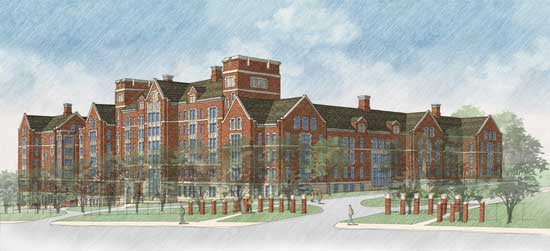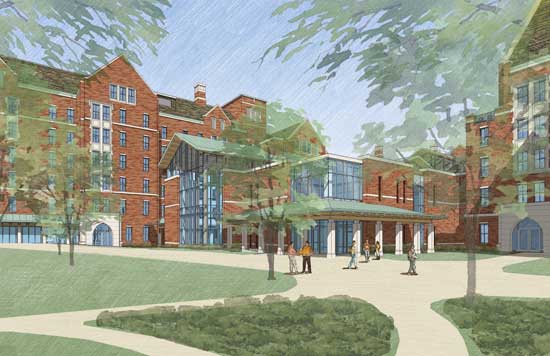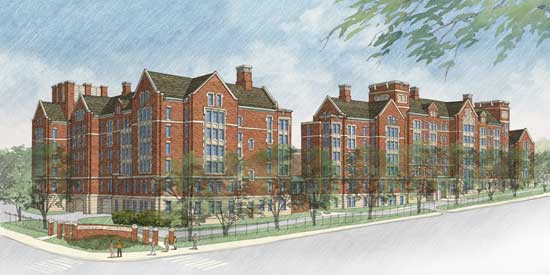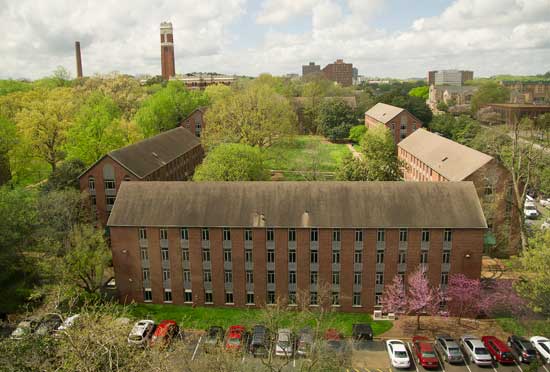College Halls at Kissam is building a better campus learning environment

Updated June 1: Scroll down to watch video of the first dorm being demolished.
Vanderbilt’s Commencement, scheduled this year for May 11, marks the traditional end of the academic year. But come the following Monday, things will really get started on campus.
That’s when construction begins in earnest on College Halls at the current site of Kissam Quadrangle. The two-year, $115 million project will tear down the six existing dorms that comprise Kissam Quad in favor of two large, state-of-the-art residential colleges connected by a light-filled central gathering and dining space. College Halls at Kissam is a top initiative of Chancellor Nicholas S. Zeppos and will be funded entirely through philanthropy and internal resources. The project, approved by Vanderbilt’s Board of Trust in April 2011, will dramatically alter the northeast corner of campus and mark a major step forward in transforming undergraduate campus life at Vanderbilt.
“Vanderbilt is dedicated to providing students opportunities to discover, teach and lead within a unique living-learning environment that values community and connectedness,” Zeppos said. “We are very fortunate and thankful for the combination of donor and alumni support and the prudent stewardship of our university community that has made possible this next phase of College Halls.”
Four years ago, Vanderbilt opened The Commons – renamed The Martha Rivers Ingram Commons last spring in honor of the university’s retiring Board of Trust chairman – as a launching pad for the first-year student’s journey through four transformative years at Vanderbilt. All first-year students now live in one of 10 houses at The Ingram Commons. Each house is guided by a faculty member, who resides among the students and encourages them to develop their intellectual, social and personal talents to the fullest. The Ingram Commons’ programming serves to connect these first-year students with upperclassmen, graduate students, faculty, staff and administrators living and working on other parts of campus.
College Halls is a natural continuation of the values nurtured during the first-year experience as well as a means of extending Vanderbilt’s academic mission beyond the classroom, according to Susan Barge, associate provost for strategic initiatives.
“We recognize that students continue to learn and grow during the many hours they spend outside of class each week, and College Halls is designed to give them accountability and ownership of their education experience. Mentors in the form of graduate students and residential faculty will guide and inspire these students,” Barge explained.
“Our goal with College Halls is to continue the trajectory started at The Ingram Commons by giving students more opportunities for leadership. With its programming, College Halls is much more than just a place to lay one’s head at night.”
It also addresses a critical need of Vanderbilt’s increasingly diverse student body. “[rquote]Our students come to us seeking community, and the way they live on campus and interact with each other and with faculty matters to their overall experience,” Barge said.[/rquote] “So College Halls is much more than a housing initiative – it’s a very deliberate way of addressing Vanderbilt’s academic mission.”
The site of Vanderbilt’s first two residential colleges is the 56-year-old Kissam Quadrangle, whose single-room residence halls were built to accommodate the influx of students to campus following World War II. Replacing the aging structures provides the opportunity to reinvent the space with new activity and living options. Along with the extensive renovation of Alumni Hall also scheduled to begin the Monday after Commencement, the project will bring a much-needed vitality to an underused portion of campus. The Alumni Hall renovation, which calls for expanded terraces, a new classroom, music lounge, exercise room, writing center, faculty office suite and café, is scheduled to wrap up in July 2013, a full year before College Halls at Kissam is complete.
Alumni Hall’s renovation – and that of Sarratt Student Center and Rand Hall, made possible by the bookstore’s move to 2525 West End last fall – will begin to “activate” that part of campus in advance of College Halls’ completion, Barge said. “We will have a lot to show for all the activity taking place here over the next couple of years.”

These spaces will serve not only the students who live at College Halls, but many, many more. In fact, all students, faculty and staff will be welcome at Kissam Center, the shared space at the heart of the new residential complex. In addition to a classroom for 65, a multipurpose room, meeting rooms and offices, Kissam Center will feature hot and cold, grab-and-go dining options and a wide variety of indoor and outdoor seating.
“The architectural details of these shared spaces, particularly in the courtyards and at the perimeter of the project, are really exciting,” said Tony Fort, Vanderbilt’s director of architecture and construction. “I think the students will love them, and I think everyone who lives in College Halls and works nearby will use these spaces and enjoy them.
“[rquote]This integration of living and learning – the fact that everyone can participate in something that is central to the university’s academic mission – is what makes College Halls so unique,” he said.[/rquote]
The two residential colleges, which have yet to be named, will house 330 students each, an equal number of sophomores, juniors and seniors. Students who wish to live at College Halls and who understand the principles and values of the residential college experience will be selected through a lottery. Each college will have a faculty director and two graduate fellows in residence. Both colleges will share an associate director, who will report to the dean of students’ office and help to develop the College Halls programming.
Once a student is selected for College Halls, he or she may choose to live there for multiple years. Organizers hope that the colleges’ variety of room types, which range from doubles to suites in as many as seven different permutations, will bring students back year after year and help to grow a long-term community.
The students should feel right at home at College Halls, which has been designed by Boston-based firm Goody Clancy with respect to the university’s original Collegiate Gothic architecture. The designers have incorporated brick-and-stone detailing, pitched roofs, ample pathways and green spaces to make College Halls feel seamless to its historic campus surroundings.

College Halls also will create an impressive new entrance to campus at the corner of West End Avenue and 21st Avenue South, which for some visitors is their first glimpse of the university. “For the first time, this corner will have the unmistakable look and feel of a college campus,” Fort said. “It will reflect the architectural integrity of the original campus, rather than simply be a perimeter building surrounded by a parking lot.”
But all this grandeur will require some sacrifice. The build-out of College Halls will encompass the Zone 2 parking along West End Avenue adjacent to Kissam Quad. Students, faculty and staff accustomed to parking here will be asked to move to nearby Terrace Place Garage. The sidewalk that runs between Kissam and Wilson Hall will remain clear throughout the construction process to give commuters and pedestrians safe and easy access to campus.
Plans call for the construction of an underground parking garage at the Kissam site that will eventually replace about two-thirds of the surface parking spaces. The garage will have an entrance off of 21st Avenue South and double as the service corridor for College Halls once it’s completed. Atop the underground garage will be an expansive “green roof” with grass and trees, adding to the outdoor spaces that students and staff can enjoy. The designers have taken care to preserve as many trees as possible at the site, including all of the iconic magnolias that form a natural curtain between campus and the street.
College Halls’ many planned features make it an extremely complicated project, not to mention the fact that all demolition, removal of materials and new construction must take place on an enclosed parcel of land, Barge said. “There is no ‘back door’ to this site. But we’ve hired an excellent contractor, Brasfield and Gorrie, known for their success with very complex building sites. We have a lot of faith in them to keep things running smoothly,” she said.
The finished College Halls will offer 400,000 square feet of usable space. “This project is huge – huge – compared to what we have now,” Barge said, “and we’re not wasting a square inch. It’s amazing the way it has all come together.”

But before the gleaming new buildings go up, the old residence halls must come down. Each will be dismantled over the course of the summer with an effort to recycle as much of the old building materials as possible in accordance with U.S. Green Building Council Leadership in Energy and Environmental Design practices. Bricks from each residence hall also will be harvested and made available as souvenirs. Other LEED-certification efforts will include bringing in new building materials from the surrounding region, using sustainable materials and making the structures as energy efficient as possible, Fort said.
“We’re going to make a bunch of noise this summer in order to get the majority of disruption over with before students return to campus in August,” Barge said. “But it will be a very active construction site for the full two years.”
Other disruptions will be to student housing. The demolition of Kissam Quadrangle means the immediate loss of 582 beds. Vanderbilt’s Office of Housing and Residential Education plans to counter this by adding a total of 300 beds through the recent acquisition of Blakemore House – a former retirement home on Vanderbilt Place that the university is renovating to open this fall – as well as by maximizing underused areas in existing residence halls. The finished College Halls will result in 660 new beds and a net increase in overall student housing capacity.
Still, about 250 more students than usual are expected to live off campus for 2012-13, said Jason Jakubowski, director of housing assignments. The university will assist them by making available its off-campus real estate holdings and negotiating with local apartment complexes to give Vanderbilt students priority housing.
Jakubowski said the inconvenience is well worth the long-term reward. “Successful living-learning communities are characterized by a high degree of student involvement, common interests and purposes, social interaction and faculty involvement,” he said. “[rquote]The finished College Halls will undoubtedly impact Vanderbilt’s residential and programmatic landscape. It will be a bricks, mortar and faculty indicator to all Vanderbilt students that they matter.”[/rquote]
On April 23, Chancellor Zeppos will host a cookout on the Kissam Quad for all undergraduate students. It will be a chance to share memories and bid the faithful residence halls farewell.
But many are eagerly looking ahead to fall 2014, when College Halls at Kissam welcomes its first cohort of students. “It will be a model of undergraduate living that will elevate the entire campus,” Barge said.